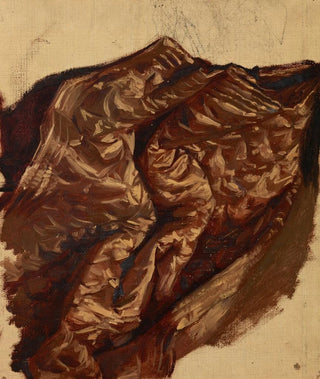Art print | Study of a brocade tapestry - Józef Simmler


View from behind

Frame (optional)
Art print of "Study of a Brocade Tapestry" by Józef Simmler – Captivating Introduction
The work "Study of a Brocade Tapestry" by Józef Simmler evokes a sense of wonder and curiosity within us. This piece, far more than a simple representation, embodies the very essence of textile and decorative art of the 19th century. Simmler, as an artist, immersed himself in the world of motifs and textures, offering a fascinating insight into weaving techniques and the richness of materials. Contemplating this work transports us to a world where the beauty of fabrics blends with the art of painting, creating a visual harmony whose depth is both captivating and inspiring.
Style and uniqueness of the work
What sets "Study of a Brocade Tapestry" apart is Simmler's technical mastery, which manages to capture the luminosity and complexity of textile patterns with remarkable precision. The vibrant colors and meticulous details demonstrate a careful attention to nuances and reflections, characteristic of brocade. The artist skillfully plays with light, creating shadows and highlights that bring the canvas to life. Each motif seems to tell a story, evoking ancient traditions while fitting into an artistic modernity. The composition itself, with its flowing lines and elegant shapes, invites the viewer to immerse themselves in a visual dialogue, where each glance reveals new discoveries.
The artist and his influence
Józef Simmler, although less known than some of his contemporaries, managed to leave his mark on his era through his unique approach to textile art. Trained in the academic traditions of his time, he combined technical rigor with artistic sensitivity. Simmler was not only a painter but also a designer, which allowed him to explore the boundaries between art and craftsmanship. His influence extends beyond his works, inspiring many artists and artisans to rediscover the importance of textiles in art history. By integrating decorative elements into his compositions, he paved the way for a new appreciation of applied arts, highlighting their rightful place in the artistic pantheon.

Matte finish

View from behind

Frame (optional)
Art print of "Study of a Brocade Tapestry" by Józef Simmler – Captivating Introduction
The work "Study of a Brocade Tapestry" by Józef Simmler evokes a sense of wonder and curiosity within us. This piece, far more than a simple representation, embodies the very essence of textile and decorative art of the 19th century. Simmler, as an artist, immersed himself in the world of motifs and textures, offering a fascinating insight into weaving techniques and the richness of materials. Contemplating this work transports us to a world where the beauty of fabrics blends with the art of painting, creating a visual harmony whose depth is both captivating and inspiring.
Style and uniqueness of the work
What sets "Study of a Brocade Tapestry" apart is Simmler's technical mastery, which manages to capture the luminosity and complexity of textile patterns with remarkable precision. The vibrant colors and meticulous details demonstrate a careful attention to nuances and reflections, characteristic of brocade. The artist skillfully plays with light, creating shadows and highlights that bring the canvas to life. Each motif seems to tell a story, evoking ancient traditions while fitting into an artistic modernity. The composition itself, with its flowing lines and elegant shapes, invites the viewer to immerse themselves in a visual dialogue, where each glance reveals new discoveries.
The artist and his influence
Józef Simmler, although less known than some of his contemporaries, managed to leave his mark on his era through his unique approach to textile art. Trained in the academic traditions of his time, he combined technical rigor with artistic sensitivity. Simmler was not only a painter but also a designer, which allowed him to explore the boundaries between art and craftsmanship. His influence extends beyond his works, inspiring many artists and artisans to rediscover the importance of textiles in art history. By integrating decorative elements into his compositions, he paved the way for a new appreciation of applied arts, highlighting their rightful place in the artistic pantheon.






